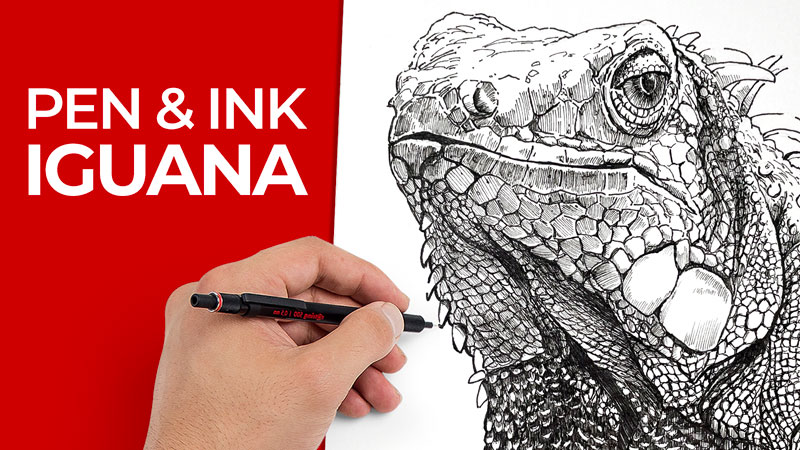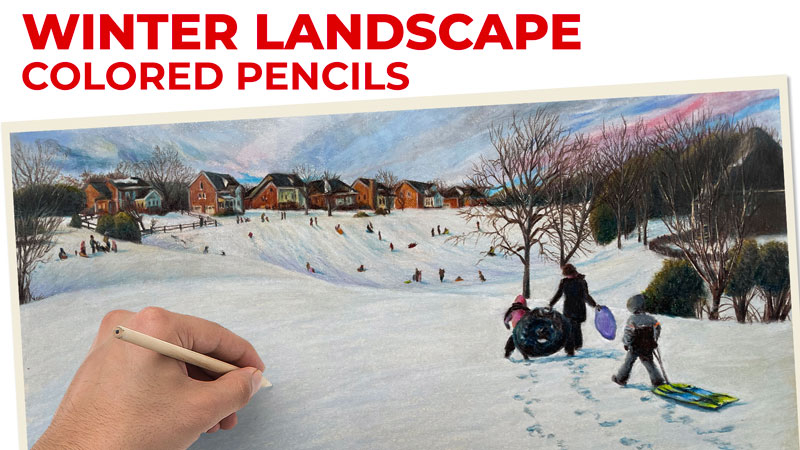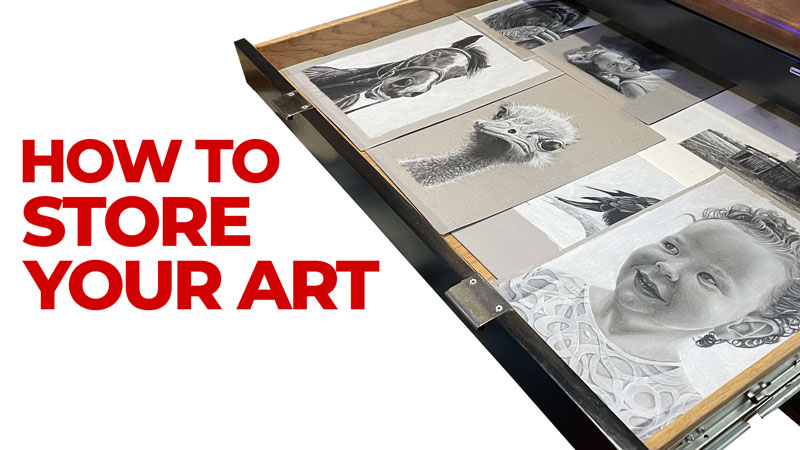
In this drawing lesson, I’ll show you the principles of drawing realistic horns and antlers. My goal is to show you that even the most whimsical form can be broken down into simple, easy to draw components. We’ll explore a method of transforming a complex task into a sequence of steps, where each action can be easily replicated.
The concluding section of our tutorial is a fully practical texture study. We’ll draw antlers with colored pencils using a reference photo.
Are They Horns or Antlers?
In colloquial speech, the words “horn” and “antler” are often used interchangeably. Sometimes they refer to any kind of head extension, even those of certain lizards, birds, and insects. However, there is a distinct difference between horns and antlers.
The Difference Between Horns and Antlers
Antlers can be found exclusively on members of the Cervidae family. It includes species of deer and moose. Antlers are paired and branched and are made entirely from bone.
In most cases, antlers present for only a few months before annual shedding. Such structures usually occur in males. (Reindeer is an exception – females have antlers, too.)
In the image below, you’ll find three examples of antlers. (1 – red deer; 2 – white-tailed deer; 3 – moose antlers.)
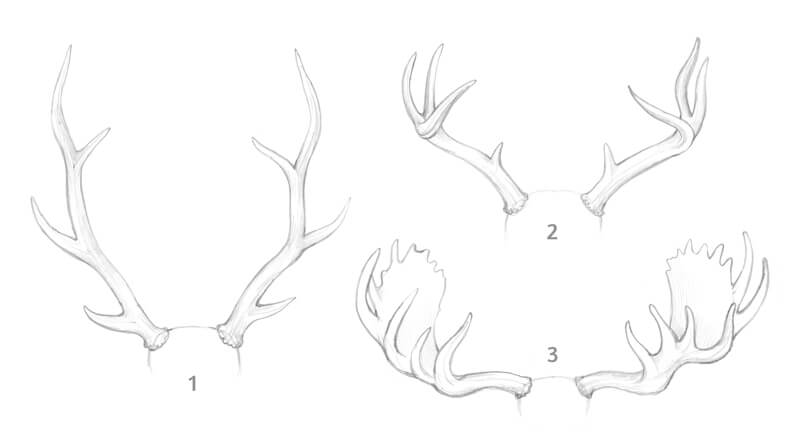
As antlers have such a complex branched structure, it’s good to know the basic terminology since this will help us draw the sturctures. Here are several characteristics that are worth remembering…
- Main beam refers to an antler’s stem.
- Secondary outgrowths are called tines.
- Burr is the lowest part of the antler – it has an interesting prominent texture.
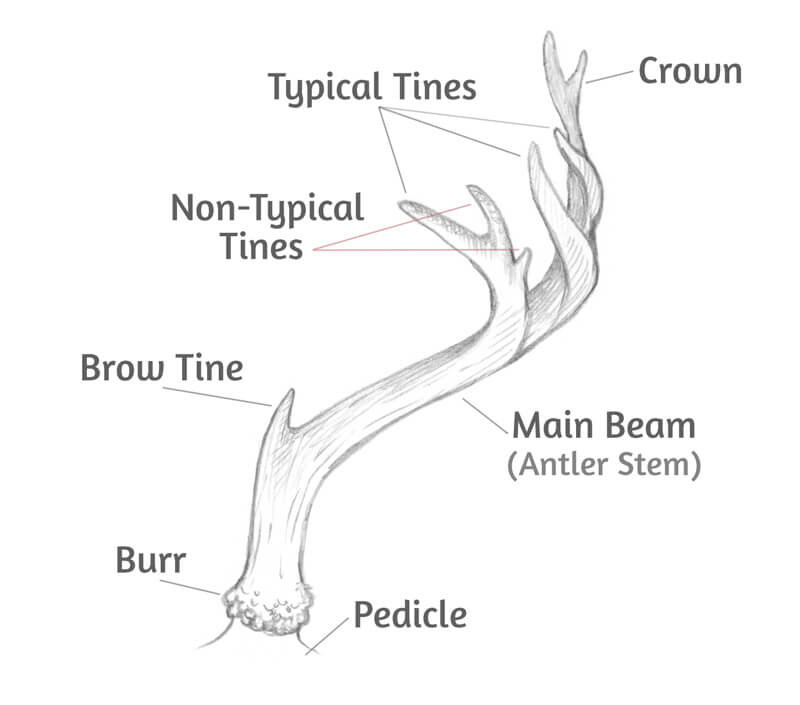
Horns on the other hand, are found on members of the Bovidae family. It includes cows, sheep, goats and also antelopes, gazelles, and even water buffalo. Horns can appear on both males and females depending on the species.
Horns are unbranched. They typically grow in symmetrical pairs. Usually, horns have a curved or spiral shape with ridges.
Another difference is that, unlike antlers, horns are a permanent feature. In many species, they grow continuously throughout an animal’s life.
The size and shape of horns vary from species to species. Below you’ll find several examples of horns. (Marking: a – Markhor; b – Saiga; c – Mouflon; d – Valais Blackneck Goat; e – Giant Eland.)
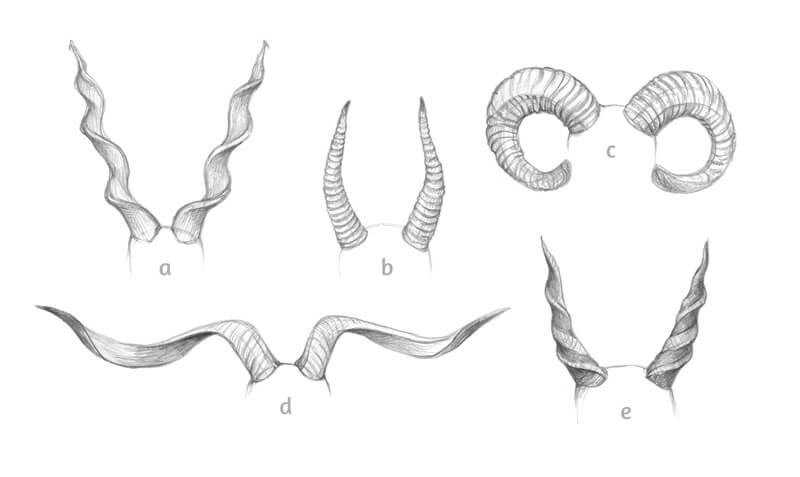
Pronghorn antelopes are the exception among horned species. They have branched, upright horns with a sheath that is shed each year.
Usually, animals have only one set of horns. However, some sheep breeds possess multiple sets of such structures. (For example, the Navajo-Churro sheep – see the image below.)
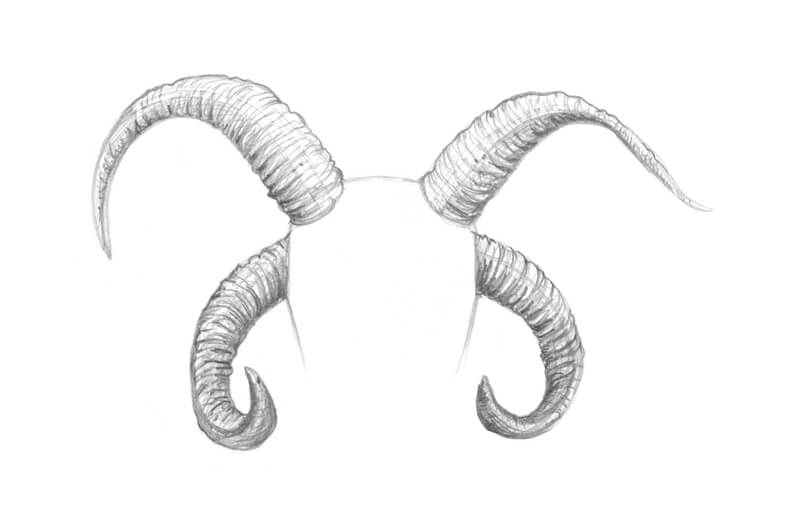
The Inner Structure and Growth Cycle
As was mentioned earlier, horns have a bony core. It is fused to the skull with connective tissue.
The core is covered with an epidermal layer. Keratin (found in the epidermis) thickens, forming the protective surface of the horn.
Antlers grow out of pedicles – two bony structures on top of the animal’s head. Pedicles support the antlers as they grow.
The antlers are made of bone. They are coated in a so-called velvet – a skin layer that supplies oxygen, blood, and nutrients to developing antlers. When the structures have grown to their full size, the velvet falls away.
In antlers, there is no covering of keratin as it is in true horns.
Below, you’ll find a comparison of the antlers and horns in early and developed stages.
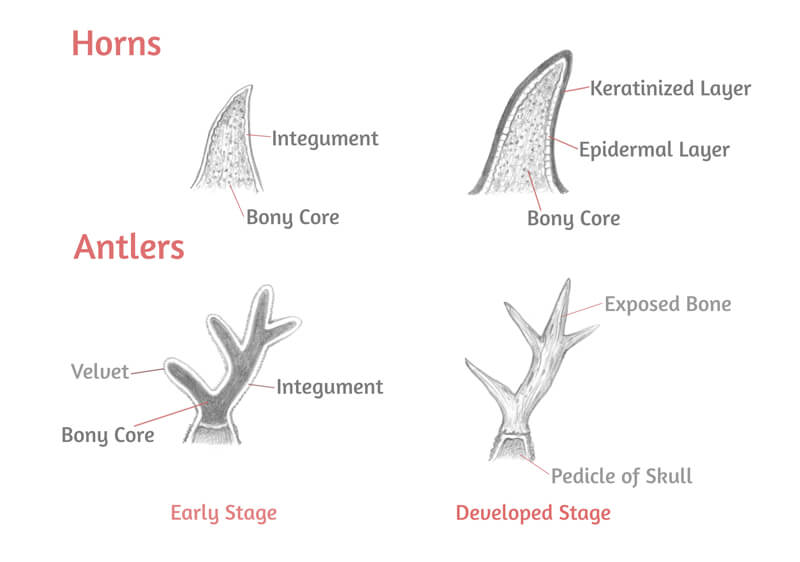
Functions of Horns and Antlers
Both antlers and horns serve quite similar purposes. Their primary function is to establish social hierarchy, dominance, and territory.
Antlers are often used in fights against other males during the mating season. They also serve as a means to impress and attract females – antlers are a prime indicator of health and genetic quality. They also provide some protection against predators.
Beyond that, there are some special functions. For example, a moose with big antlers has better hearing than one without them.
Reindeer use their antlers to clear away snow to eat plants that are hiding underneath. It is interesting to know that reindeer females keep their antlers during the winter months. They are shed only in the spring – after the calves’ birth. Most likely, the antlers are retained because of their important role in the nutrition process.
Males of the Bovidae family also use their horns in fights during the breeding season. In species where females also sport horns, they’re usually smaller and serve rather as a defensive tool.
How to Draw Antlers and Horns
Now that we know quite about antlers and horns, let’s look at a simplified way to draw them.
A Structured Approach
Now I’ll show you a sequence of steps that you can apply to any drawing process. We’ll use it to draw deer antlers.
Our initial task is to simplify the subject as much as possible. Try to imagine the antlers’ inner structure, as if they’re made of glass or another transparent material.
The form of real antlers’ main beams can be stylized to an elongated conus. The tines are smaller cones that are attached to the main form.
First, I mark the basis of each antler with an ellipse. It helps to create a space that this element takes up on the head’s surface.
Then I mark the direction of each stem with long core lines. They reflect mild twists that are inherent to antlers. (In the image below, point 1.)
I often use a subsidiary line that intersects the top center of the skull. It allows me to check the symmetry of the antlers. However, such natural structures usually look slightly unequal in comparison, so symmetry is relative.
Then I add the outer contours of the main beams. (Point 2.) If you’re using a reference, evaluate how thick or thin the stems are – compare their width with the animal’s head or other body parts.
See also: 7 Drawing Techniques For Accuracy
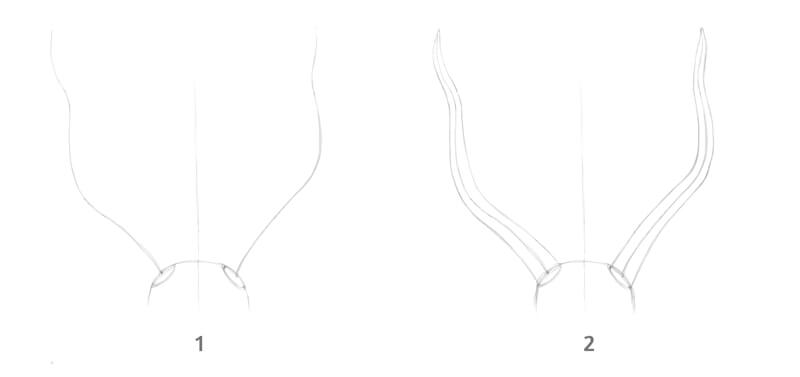
Now it’s time to add the secondary outgrowths – the tines.
I mark the foundations of the tines with ellipses, too. There may be smaller elements that grow out of tines – they are added last. (See point 3 in the image below.)
The framework is complete and now we can refine the contours. It may mean widening or narrowing certain parts, and also making the lines smoother or more curved. For example, I’ve broadened the lower part of the antlers where the burr is located.
We can shade the darker areas – this will give the drawing some volume. Also, it’s time to add textural details. (Point 4.)
Note that texture affects the look of the antlers’ main contours, making them somewhat irregular.
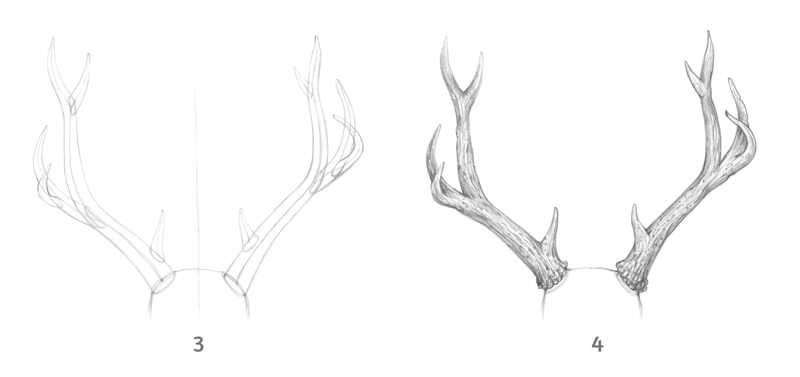
How to Analyze the Shape of Horns
Any process of drawing horns or antlers can be broken down into the same steps that we’ve followed in the previous paragraph.
- Mark the starting and ending points. Outline the direction of each horn.
- Add the outer contours of forms, starting with larger ones.
- Add the appropriate details. Refine the drawing, if necessary.
- Complete it with shading and texture.
Sometimes the horn-like structures present such a complex appearance that we may feel overwhelmed. This part of the tutorial includes a collection of tips that will help you to analyze such forms.
Please note that I’ll be using the word “horns” in the majority of cases, but these methods can be applied to antlers, too.
See the Form as a Set of Shapes
Try to imagine the horns as a combination of flat shapes or planes. You can do it just in your mind – or, draw a simple scheme on a piece of paper. The goal is to create a visual distinction between the parts or sides of a horn.
Notice where different planes change direction. A specific part of the horn may go forward or backward or it can turn aside. Observe these bends and transform them into stylized shapes.
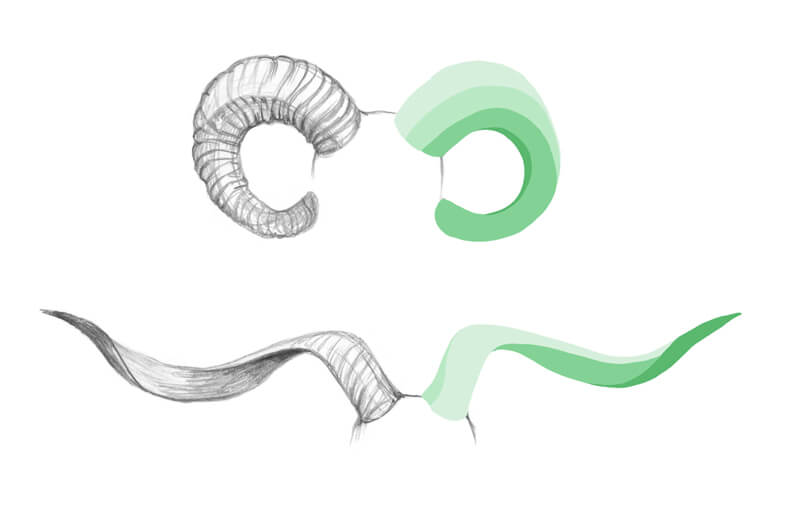
Imagine That the Form of the Antler Is Transparent
In the case of curved or spiral horns, it may be useful to envision the inner structure. Pretend that the object is made of glass. Look for repeating patterns or imaginary lines of relief.
Below you’ll find an illustration of this concept. The green line follows the curve. It envelops the whole form – from its top to bottom. This line becomes interrupted at the horn’s back side.
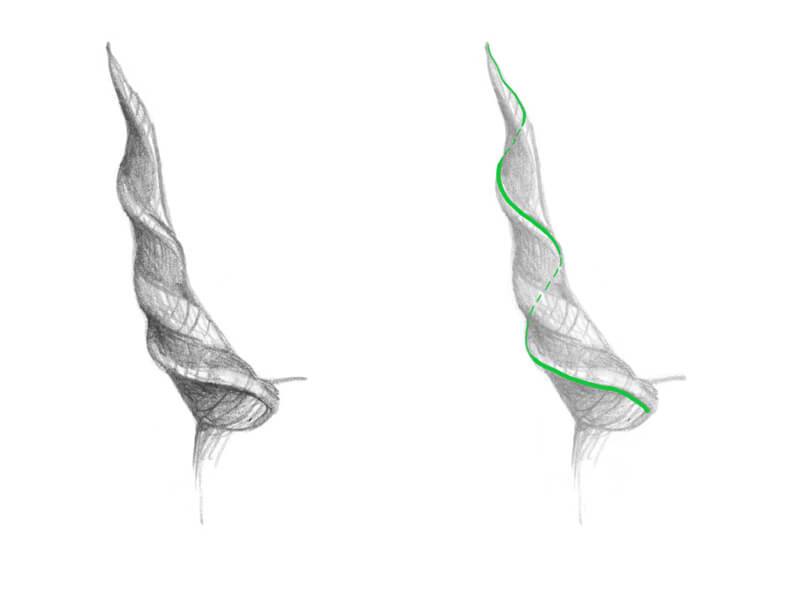
“Chopping” the Form
If you draw ribbed horns, try to simplify the form so that it looks chopped. As a result, curved areas will become flat, straightened. This trick makes the planes (or facets) clearly readable.
Observe each plane’s direction in space and its visibility to a viewer.
Also, pay attention to the areas near the horn’s edges. Chances are that you’ll be able to trace an imaginary line that follows the contours of the form. In the image below, such lines are marked with blue and green colors.
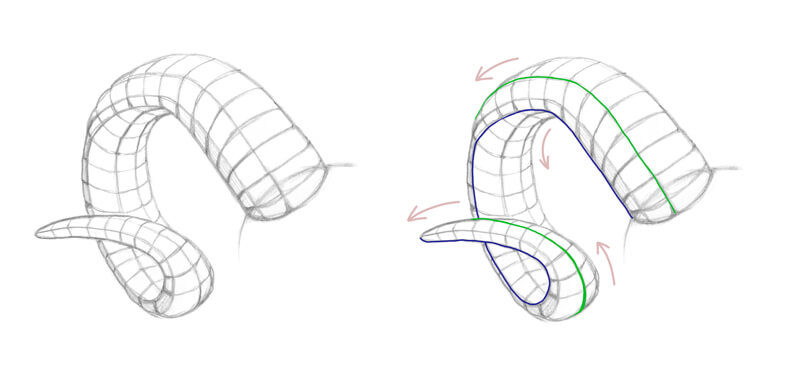
Drawing Horns and Antlers in Perspective
It’s necessary to remember that horns, just as any other object, conform to the principles of perspective. However, we don’t have to create a strict technical design that includes a horizon line, vanishing points, and guides.
See also: Linear Perspective
The best way to grasp this concept is to observe live animals with horns. (Alternatively, use reference photos.) You’ll notice how these head extensions look in different perspectives causing foreshortening.
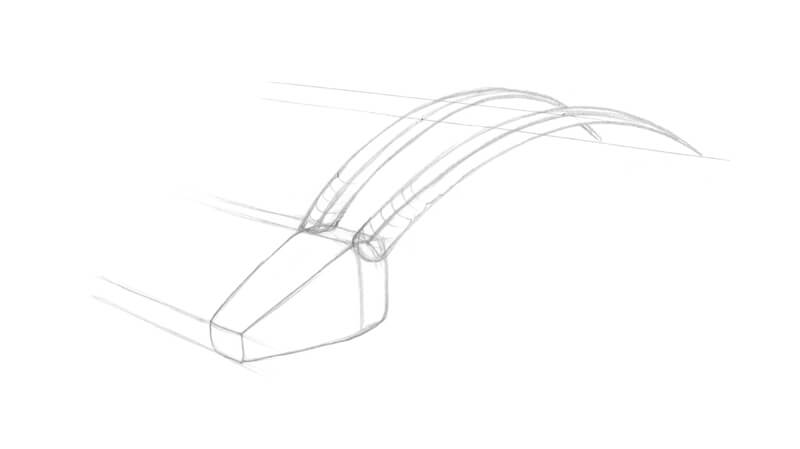
Adding Color to the Drawing with Colored Pencils
It’s time to sharpen our pencils – we’re ready to start drawing with colored pencils! Let’s reinforce our newly discovered drawing knowledge.
It’s important to set a goal for your drawing practice. What’s your desired outcome – a detailed scientific illustration, a quick loose sketch, or a study of a texture’s fragment? The purpose determines the amount of effort and time that should be invested.
My goal is to observe the subject and learn something new about its structure and texture. Such valuable takeaways can be used in a more complex and elaborate artwork. I aim to complete this drawing within several hours, so probably it won’t be perfectly detailed. My result won’t be an accurate copy of the reference.
The Art Supplies for This Drawing Exercise
For this project, I’ll be using Faber-Castell Polychromos colored pencils. You’ll find the swatches in the image below.
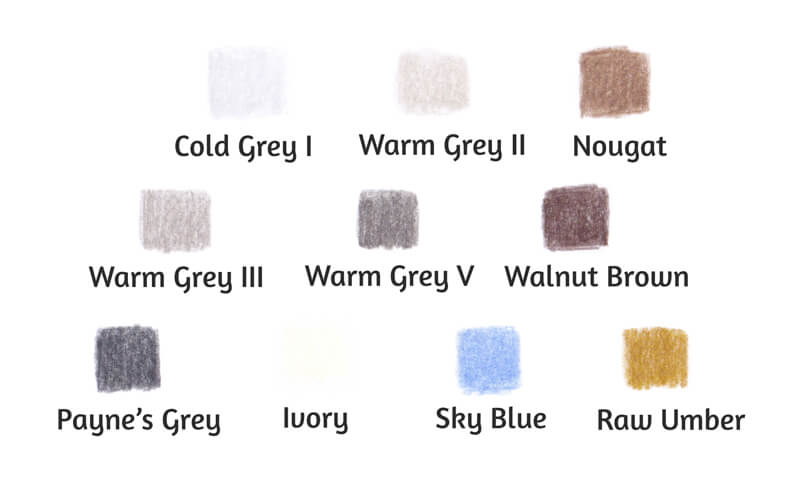
Please note that it is possible to complete this drawing with fewer pencils. An absolute minimum includes three greys (light, medium, and dark) and one brown. Of course, an extremely restricted palette won’t allow creating subtle color nuances, but you’ll still be able to draw and learn by doing.
See also: How to Draw a Seashell with a Limited Palette with Colored Pencils
I’ll be drawing on an A4 sheet of thick drawing paper with a subtle texture.
Also, keep a graphite pencil, a soft eraser, and a pencil sharpener at hand.
See also: 9 Must Have Colored Pencil Supplies
The Reference Photos Used for This Drawing
Our subject matter is Roe deer antlers. Feel free to use this image to follow along!
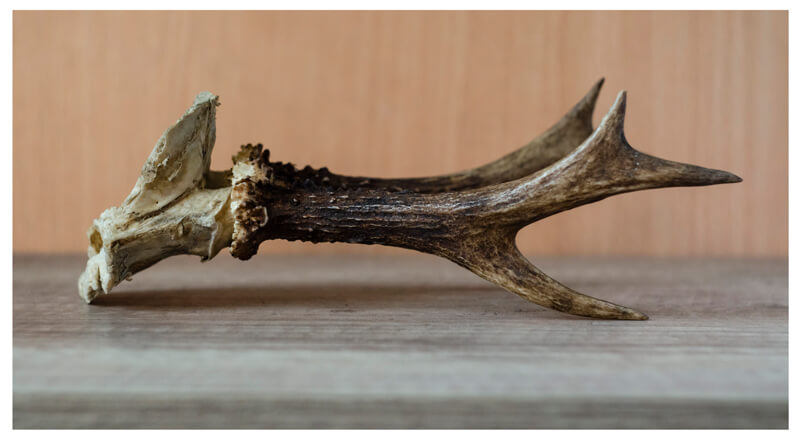
And here are some fragments of texture in close-up. Note that each area of an antler has specific textural qualities.
The burr is coarse and has prominent relief. The antler stem demonstrates a rough surface with long shallow furrows. The top part of the main beam and the upper tines have a smoother, more unified texture.

Create an Sketch of the Antlers
Let’s sketch the antlers. At this stage, the drawing will be rough and approximate. It is like a “box” for our object.
I present the skull as a set of shapes. Shape 1 is the side that is turned away from the viewer. Shape 2 presents the upper plane and shape 3 is the lower part of the bony area. The top projection is marked with green.
I also add the rough borders of the closer antler and its tines.
In this case, I don’t use many subsidiary lines, such as a core line and various ellipses that mark tines’ bases. These Roe deer antlers have a simple structure.
Keep the graphite marks as light as possible, and please note that I’ve intensified the lines in my sketch for your convenience. Heavy marks may be difficult to erase.
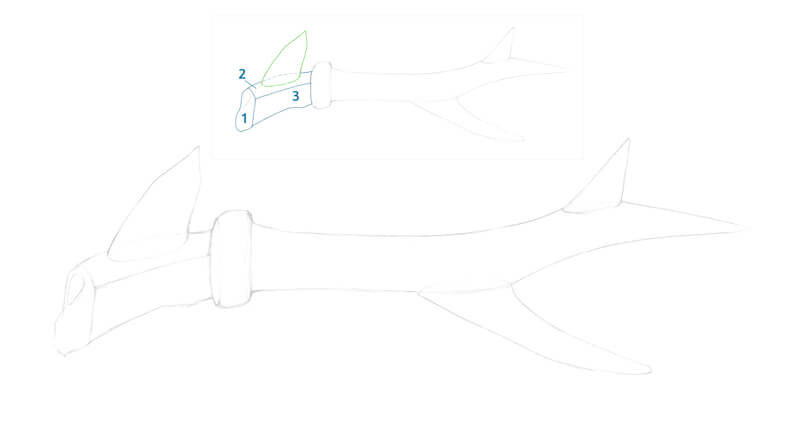
Now I refine the contours of the subject, removing unnecessary lines. Take your time to observe the reference and notice important details. Transfer them to your drawing.
At this step, I add the second antler.
Besides the contour line, I don’t include the details of the antlers’ texture. However, if that helps you to study the subject, please mark some furrows and bumps.
When the underdrawing is complete, soften the graphite marks with an eraser.
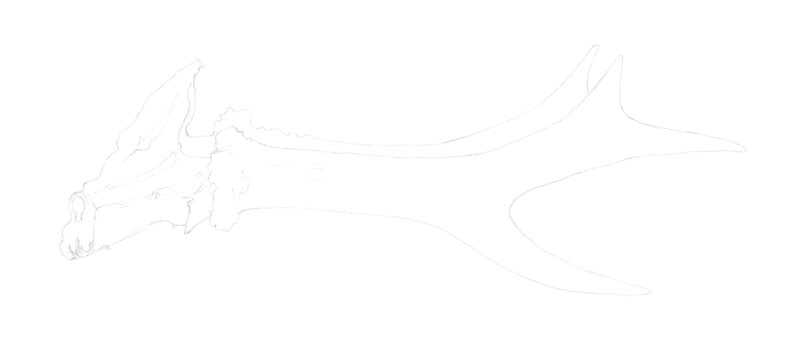
A Quick Note on Working with Texture
Before we proceed to colored pencils, let’s make a quick digression.
Some materials present a greater challenge for the artist. The surface of horns or antlers may be considered as such an example. This texture has so many details!
Here is one of the tricks that may help you to grasp the essence of this material. Take a photo of your subject matter and switch it to a black and white version. When you remove the colors, the relief of the surface becomes much more visible. The values will be clearly readable too.
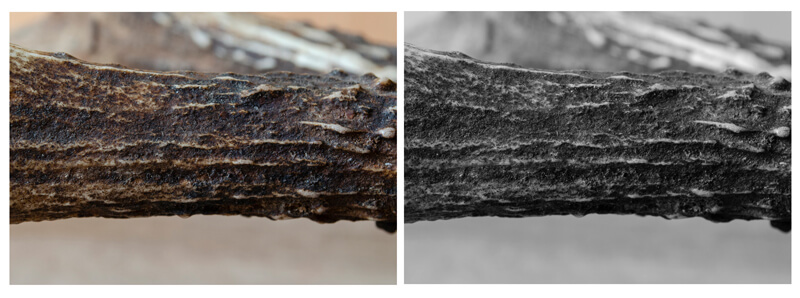
Also, it may be a good idea to start with a study of texture. Focus on one fragment at a time, and you’ll find that complexity is just an illusion.
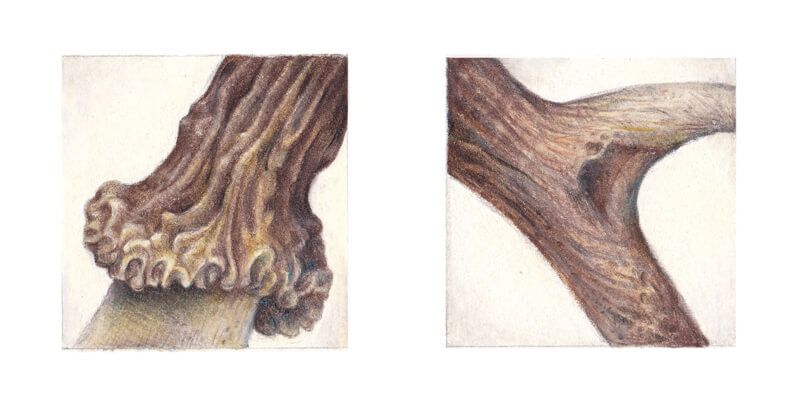
And the last piece of advice – make sure that you spend enough time observing the texture. It might bring you unexpected insights!
Drawing the Antlers With Colored Pencils
Let’s start with a color base.
I cover the bony part, using Cold Grey I. Some areas of the skull seem to have a cool undertone. A subtle contrast in color temperature will make the drawing livelier.
See also: Warm vs. Cool Grays
With Warm Grey II, I cover the lighter areas of the antlers.
I add Nougat to the darker parts of the antlers. The antler that is farther from the viewer gets a more unified covering because it should stay in the background. Too many details of texture will push it forward visually.
The applications of Warm Grey II and Nougat may overlap each other.
I make sure that I spend enough time observing my model. When I notice a specific detail, I transfer it to my drawing. However, we don’t have to make a hand-drawn copy of the subject matter. It is more important to convey the perceived feel of the texture.
I keep light pressure on the pencils. My fingers create a back-and-forth movement that is also known as directional lines.
See also: Colored Pencil Techniques: A Practical Guide
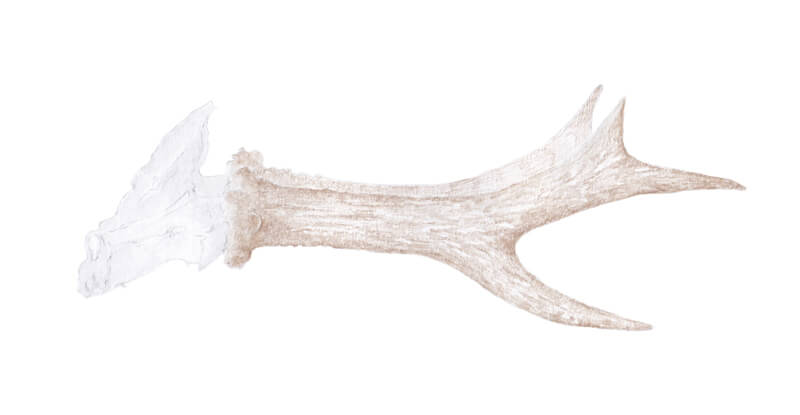
With Warm Grey III, I work on the midtones found on the skull.
Then I use Warm Grey V to accent the shadowed areas. The applications of these two greys may overlap – this will create a soft value transition.
I carefully observe my reference, still searching for valuable details. Those nuances will make our drawing more credible.
I add Walnut Brown to the antlers. The covering is slightly irregular. It has gaps that conform to the overall look of the texture. I create furrows with longer lines. The marks repeat the direction of the hollows.
I accent the burr and the main beam with an additional layer of pigment.
In my reference photo, the farther antler demonstrates lower value, so I darken it additionally.
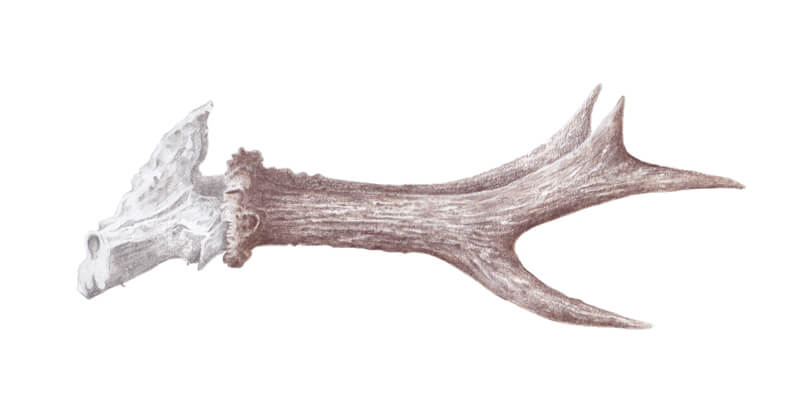
I increase the contrast, using Payne’s Grey. This pencil has a nice cool undertone that is great for creating shadows.
While working on the antlers, make sure that you keep light pressure. Also, avoid covering the prominent details of the texture.
I use Walnut Brown to strengthen the bone’s core shadows. The pressure is very light. The inclusion of this shade will unite the artwork in terms of color.
Note that we usually see fewer details in the highlighted and the shadowed areas. Let the covering be slightly unified there.
Also, decide what area should get an emphasis. Something similar happens when we take a photo. We focus on a particular area, while other parts of the image become a bit blurry. They’re out of focus, and the details are not as crisp there.
I’m going to accent the middle part of the main beam that is closer to the viewer. This area will require a more detailed elaboration.
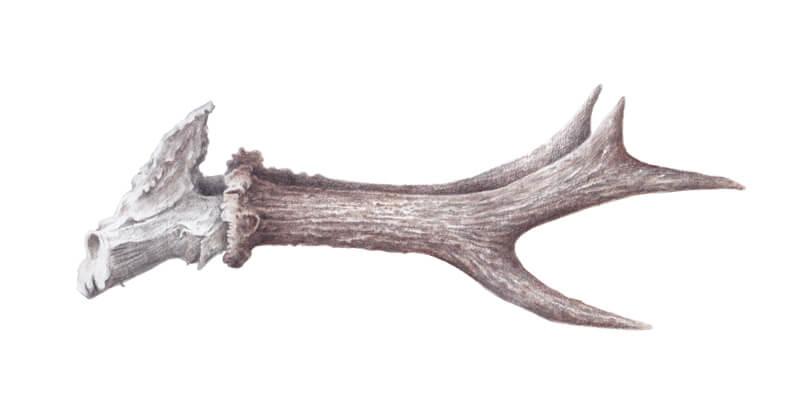
With Ivory, I cover the upper areas of the skull. I use the pencil’s tip to move the pigment found on the paper, so the covering becomes more polished. This tint creates a slight change in the color temperature. It conveys the gentle touch of light.
I apply this color to the antlers, accenting the lighter areas.
The tines have a smoother texture, and Ivory can be used to express this feature. I keep an increased pressure to polish those areas.
I add Raw Umber to the burr and bony part. It creates interesting color nuances that make the drawing more vivid.
At this stage, I pay less attention to the model. Instead, I start treating my drawing as an independent art object. I prioritize its visual credibility over the conformity to the reference.
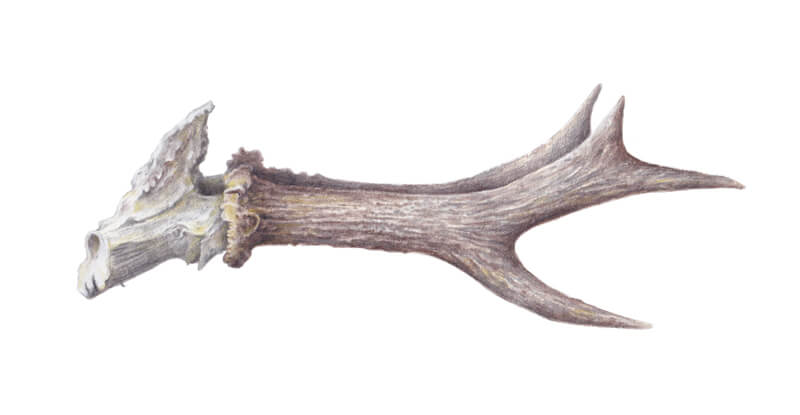
I apply Walnut Brown and Payne’s Grey interchangeably to increase the contrast and deepen the shadows. I cover the antlers, leaving the most prominent details untouched. The darker areas of the skull get an additional layer of shading, too.
When we work on a textured object, it may be tempting to dive into creating all kinds of details. At the same time, it’s necessary to evaluate the main form – does it look three-dimensional? Are the core shadows dark enough to create a sense of volume?
I mute down all the areas that still seem plain and unexpressive. The texture in the darker areas becomes slightly smoother. I get rid of excessive roughness, including the specks of paper that may be showing through the applications.
It’s possible to use Nougat to create additional color nuances and details of texture.
I use Sky Blue at a light pressure to create a nice cool accent at the upper tines. Also, we can add this color to the side of the skull that is turned away from the viewer.
I recommend taking a break before you call this artwork finished. Come back with fresh eyes and chances are that you’ll find something that requires a final touch.
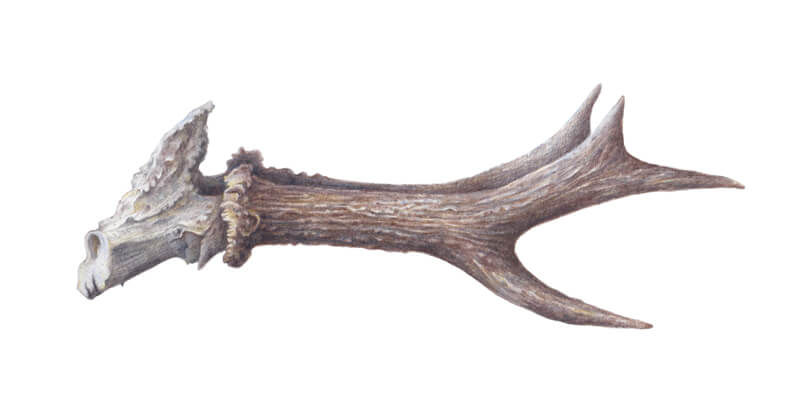
Here are close-up samples of hand-drawn textures. They include the bony part area, the antler stem, and tines.
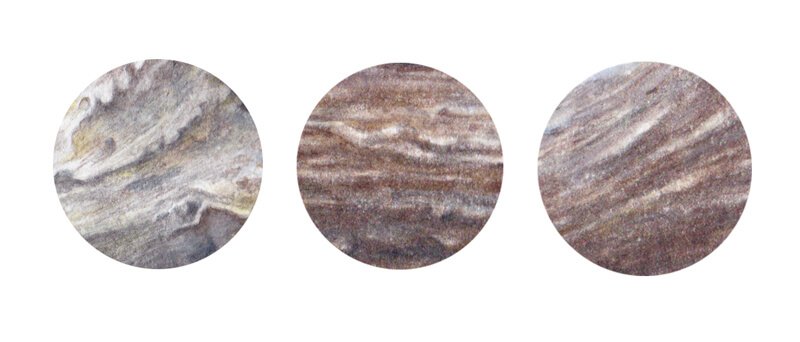
I create a cast shadow, using Payne’s Grey and Walnut Brown. I work with long lines, holding a pencil at an angle, so its body produces the marks.
I layer the applications on top of each other. The cast shadow should be dark enough to emphasize the antlers. Let its edges be blurry.
The darkest areas of the cast shadow are near the points where the object is touching the supporting surface.
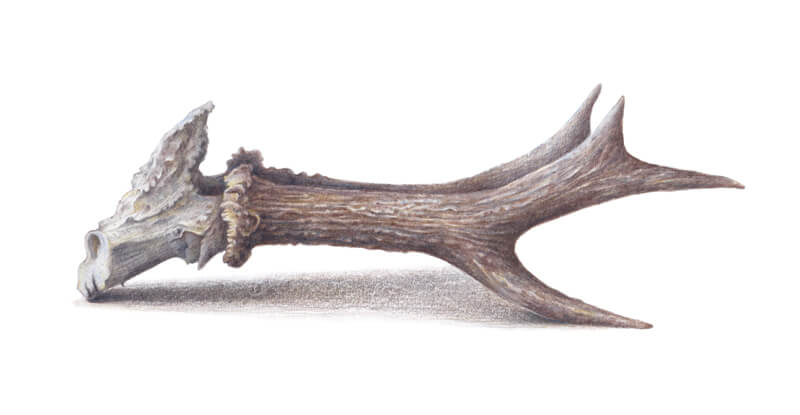
Drawing Antlers and Horns – Conclusion
Congratulations – we’re at the end of this lesson! Time flies when you’re focused and having fun. We’ve created a wonderful texture study and, hopefully, gained some insights and new knowledge.
Thank you for being with me on this journey. I wish you much inspiration for your future projects!
If so, join over 36,000 others that receive our newsletter with new drawing and painting lessons. Plus, check out three of our course videos and ebooks for free.



